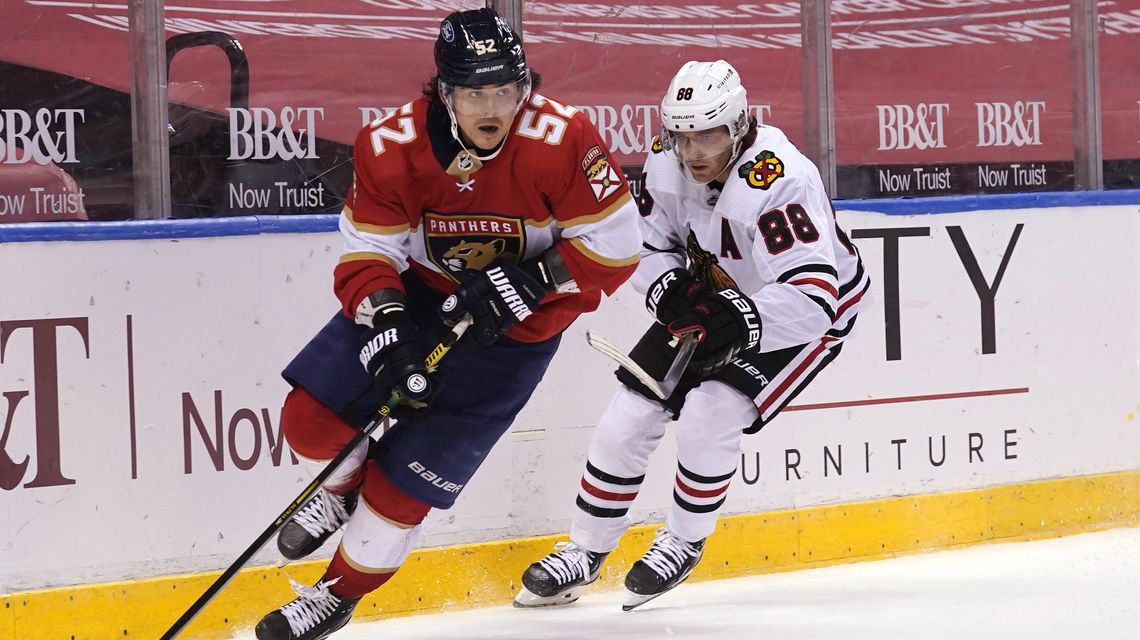
Under the radar: The subtle flourishing of MacKenzie Weegar
SUNRISE, Fla. (BVM) — The Norris Trophy is awarded at the end of each NHL season to the player voted to be the best defensemen. Looking at the top vote getters, you see some familiar faces: young stars like Adam Fox, Cale Makar and Charlie McAvoy, mainstays like Victor Hedman and Kris Letang, and goal scorers like Dougie Hamilton, Jakob Chychrun, and Darnell Nurse; then there’s MacKenzie Weegar.
Weegar doesn’t fit very well into any of these categories. He is 27 years old, so not very young, has good but not great offensive production (6-30-36 in 54 games last season), and definitely isn’t a household name. So where did this player drum up the support to be voted as one of the best ten defensemen in the NHL last season? To answer simply, his analytics.
There has been a grassroots uprising from the analytics community in support of Weegar. Analytics can get confusing and sometimes proprietary, so we’ll just look at a few easily accessible underlying numbers that explain some of the support behind Weegar.
Defensive Zone Starts Percentage (dZS%) is a pretty simple stat. It is the percentage of times a player starts their shift with a defensive zone faceoff vs. an offensive zone faceoff. Neutral zone faceoffs are not counted here. This stat gives a good idea of a player’s situational use. Does their team trust them starting in their own defensive end or does their team want to shelter them?
Fenwick For Percentage (FF%) is another straightforward stat, shots + misses by a player’s team while said player is on the ice divided by the shots + misses of the opposing team while the player is on the ice. Fenwick gives a good encapsulation of which team is controlling play while a player is on the ice. If a player’s FF% is less than 50%, the opposition is controlling play when that player is on the ice.
It should also be said that analytics in hockey focuses heavily on different situations, so all of these numbers are only taking into account even-strength play.
Fourteen defensemen in the NHL play over 20 minutes per game and have a dZS% of 50% or more. Of those 14, many of them have an FF% that is less than 50%, which adds up, if you are starting your shifts in your own zone it is harder to create shots and easy to have shots taken against your team. Only five of those 14 players have a FF% of more than 50%: The Pelech and Pulock pairing from the Islanders, a pairing widely considered to be one of the best in the league; Brady Skjei, Ivan Provorov, and, with the highest FF% of the group by a wide margin: MacKenzie Weegar.
So, what do all those numbers mean exactly? Essentially, this data means that Weegar, despite starting a large number of his shifts in his own zone, still manages to produce more offense than his opposition. Weegar breaks the puck out very well and gets play moving in the right direction, and for a team like Florida that heavily relies on the rush and their speed, that’s a huge boon.
There are people that aren’t satisfied with being told to look at numbers and believe a player is good, but there is an easy solution to that: watch the guy play. Watch highlights for any Panthers game, his game is very good. He’s immensely strong in the corners, which helps with his ability to break out the puck. He plays with an edge and can separate players from the puck, though he does take an occasional unnecessary penalty. The thing that stands out the most from Weegar’s game is his hockey sense. He makes good decisions, he makes the right passes, he jumps up into rushes at the right times, he’s just smart. Weegar just moves play in the right direction, away from his own net and into the opposing zone.
Hockey Reference has a great tool called “Similarity Scores” where it takes one player and compares their career to other players using Point Shares, a basic approximation of a player’s value. Weegar in five seasons into his NHL career, the player that matches his career the closest? Dan Boyle. Another right-shot, similar–sized player with an edge, Weegar and Boyle play very similar games. Boyle broke out late, too (26 years old), much like Weegar. Will Weegar ever be the offensive point-producer Dan Boyle was? Probably not, at least not as long as he plays with Aaron Ekblad and gets little power-play time as a result. But is it reasonable to think Weegar could become a similar two-way dominant player like Boyle over the next few years? Definitely, and the numbers back it up.




